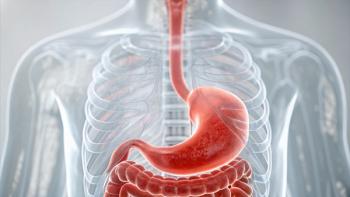
Chemoradiotherapy Plus Capecitabine Delivers Superior Failure-Free Survival in High-Risk Nasopharyngeal Carcinoma
At a 5-year follow-up, the failure-free survival rate with capecitabine was 83.3% vs 72.2% with observation.
Following treatment with chemoradiotherapy (CRT), patients with locally advanced nasopharyngeal carcinoma (NPC) may derive clinical benefit with adjuvant capecitabine, according to phase 3 findings published in JAMA Oncology. The results showed that the adjuvant treatment prolonged failure-free survival (FFS) in a pool of patients with NPC who presented with at least 2 high risk factors.
In the open-label, randomized clinical trial (NCT02143388), 180 Chinese patients were assigned to capecitabine or observation following CRT. Investigators found that those in the capecitabine group (n = 90) had superior FFS to those assigned to observation at 3 years (83.3% vs 72.2%) and 5 years (78.5% vs 65.9%; HR, 0.53; 95% CI, 0.30-0.94; P = .03).
NPC is a unique head and neck cancer endemic to East Asia and Southeast Asia and associated with Epstein-Barr virus (EBV). Most patients present with locally advanced disease and metastatic recurrence in the bones, liver, and lungs is common.
Previous findings have demonstrated that capecitabine monotherapy has efficacy in recurrent metastatic NPC, and the agent has shown promise in combination with induction chemotherapy. Investigators in this trial sought to determine if capecitabine plus CRT improved FFS in the locally advanced patient population. These results were collected after a median follow-up of 58.0 months after patients received a full dose of capecitabine for 6 months.
Eligible patients aged 18 to 70 years were required to have histologically confirmed, newly diagnosed, nonkeratinizing NPC; Karnofsky performance status of at least 80 points, TNM stage III-IVb disease, and the presence of at least 1 unfavorable prognostic factors: T3-4N2 or T1-4N3; plasma EBV DNA titer higher than 20,000 copies/mL; primary gross tumor volume greater (GTV) than 30.0 cm3; a maximum standard uptake value of primary GTV higher than 10.0 on fluorodeoxyglucose F18 PET/CT, or multiple nodal metastases and at least 1 larger than 4.0 cm. Patients were not allowed to have received prior radiotherapy, chemotherapy, or surgery except for diagnostic investigations.
All patients received CRT and 100 mg/m2 intravenous cisplatin every 3 weeks for 2 to 3 cycles depending on the duration of radiotherapy. Patients randomly assigned to the experimental arm (n = 90) then received 8 cycles of 1000 mg/m2 twice-daily oral capecitabine for 14 days every 21 days beginning 4 weeks after CRT. Investigators modified chemotherapy doses based on the nadir blood counts and acute toxic effects of the preceding cycle.
Investigators determined that pretreatment clinical characteristics were comparable between groups. Fourteen patients (15.6%) in the experimental group had 1 unfavorable risk factor, 31 (34.4%) had 2 risk factors, and 45 (50.0%) had 3 or more risk factors. In the control group, 10 (11.1%) had 1 unfavorable risk factor, 42 (46.7%) had 2 risk factors, and 38 (42.2%) had 3 or more risk factors.
The median patient age was 46 years (range, 39-55) in the capecitabine group vs 48 (range 41-55) in the control group. Most patients in both arms (81.1% vs 77.8%, respectively) were male.
Eighty-five (94.4%) patients received capecitabine, 71 (78.9%) of whom completed all 8 cycles of treatment.The median relative dose intensity of capecitabine was 100% (interquartile range, 84.7%-100%).
The rates for 3-year overall survival (OS) were 93.3% for the capecitabine group vs 87.8% for the control group (HR, 0.62; 95% CI, 0.29-1.32). The rates for 3-year distant metastasis-free survival also favored the experimental arm at 85.5% vs 80.4% in the control arm (HR, 0.69; 95% CI, 0.35-1.35). Rates for 3-year locoregional relapse-free survival were 97.5% for the capecitabine group vs 84.1% for the control group (HR, 0.28; 95% CI, 0.10-0.76).
Investigators observed no interaction between high-risk factors and treatment. However, the addition of adjuvant capecitabine favored the subgroup of patients who had risk factors with a maximum standard uptake value higher than 10.0, a primary GTV larger than 30.0 cm3, and an EBV DNA titer higher than 20,000 copies/mL.
Seventy-eight (86.7%) patients in the capecitabine arm had complete response and 12 (13.3%) had partial response compared with 79 (87.8%) and 10 (11.1%), respectively, in the control arm. One patient in the control arm could not be assessed.
Nineteen (21.1%) patients required capecitabine dose reductions, 11 because of hand-foot syndrome, 4 because of gastrointestinal adverse events, 2 because of recurrent myelosuppression, 1 because of fatigue, and 1 because of treatment noncompliance.
Fifty-four (60.0%) patients in the experimental arm experienced grade 3 treatment-related adverse events (TRAEs) compared with 46 (51.1%) in the control arm. The most common grade 3 TRAEs were xerostomia (18.9% vs 10.0%, respectively), mucositis (23.3% vs 16.7%, respectively), and anorexia (8.9% vs 4.4%, respectively). One patient in each group experienced grade 4 TRAEs.
Nine of 83 (10.8%) patients in the experimental arm experienced delayed grade 3/4 TRAEs compared with 7 of 81 (8.6%) in the control arm. Investigators said incidence of any-grade delayed TRAEs was comparable between the 2 groups except for a higher incidence of ototoxicity (69.9% vs 58.0%) and grade 1 xerostomia (59.0% vs 49.4%) in the experimental arm.
Reference
Miao J, Wang L, Tan SH, et al. Adjuvant capecitabine following concurrent chemoradiotherapy in locoregionally advanced nasopharyngeal carcinoma: a randomized clinical trial. JAMA Oncol. Published online October 13, 2022. doi:10.1001/jamaoncol.2022.4656
Newsletter
Knowledge is power. Don’t miss the most recent breakthroughs in cancer care.






























































































